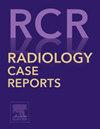Unmasking an idiopathic reno-caval fistula: A rare etiology of right-sided high-output heart failure
Q4 Medicine
引用次数: 0
Abstract
An aortocaval fistula is a rare vascular connection between the aorta and inferior vena cava, often caused by abdominal aortic aneurysm, trauma, or infection. It can result in high-output heart failure due to increased venous return and reduced systemic vascular resistance, typically presenting with right-sided symptoms. Renal arteriovenous and reno-caval fistulas are even rarer, with no prior reports of spontaneous idiopathic reno-caval fistulas. A 67-year-old man with hypertension and paroxysmal atrial fibrillation presented with 10 months of generalized edema and exertional dyspnea. He had no history of abdominal trauma or surgery. Examination revealed signs of congestive heart failure and a central abdominal bruit. Echocardiography showed chamber dilation and pulmonary hypertension. Computed tomographic angiography identified a right reno-caval fistula between the right renal artery and inferior vena cava, with associated right renal infarction. The patient underwent successful endovascular embolization using a vascular plug, with gradual resolution of symptoms and improved echocardiographic findings. In cases of high-output heart failure with right-sided symptoms, arteriovenous fistula should be considered, as specific interventions can be highly effective. This rare case underscores the value of a multimodal diagnostic approach combining clinical evaluation and imaging to ensure accurate diagnosis and successful treatment.
揭露特发性肾腔瘘管:右侧高输出量心力衰竭的罕见病因
主动脉下腔静脉瘘是一种罕见的连接主动脉和下腔静脉的血管,通常由腹主动脉瘤、创伤或感染引起。由于静脉回流增加和全身血管阻力降低,可导致高输出量心力衰竭,通常表现为右侧症状。肾动静脉和肾腔瘘管更为罕见,以前没有自发性特发性肾腔瘘管的报道。一个67岁的男性高血压和阵发性心房颤动提出了10个月的全身性水肿和用力呼吸困难。他没有腹部外伤或手术史。检查显示有充血性心力衰竭和中央腹部肿块的迹象。超声心动图显示心室扩张和肺动脉高压。计算机断层血管造影发现右肾动脉和下腔静脉之间有一个右肾腔瘘,并伴有右肾梗死。患者成功接受了血管内栓塞治疗,症状逐渐缓解,超声心动图结果也有所改善。在伴有右侧症状的高输出量心力衰竭病例中,应考虑动静脉瘘,因为具体的干预措施可能非常有效。这个罕见的病例强调了多模式诊断方法结合临床评估和成像的价值,以确保准确的诊断和成功的治疗。
本文章由计算机程序翻译,如有差异,请以英文原文为准。
求助全文
约1分钟内获得全文
求助全文
来源期刊

Radiology Case Reports
Medicine-Radiology, Nuclear Medicine and Imaging
CiteScore
1.10
自引率
0.00%
发文量
1074
审稿时长
30 days
期刊介绍:
The content of this journal is exclusively case reports that feature diagnostic imaging. Categories in which case reports can be placed include the musculoskeletal system, spine, central nervous system, head and neck, cardiovascular, chest, gastrointestinal, genitourinary, multisystem, pediatric, emergency, women''s imaging, oncologic, normal variants, medical devices, foreign bodies, interventional radiology, nuclear medicine, molecular imaging, ultrasonography, imaging artifacts, forensic, anthropological, and medical-legal. Articles must be well-documented and include a review of the appropriate literature.
 求助内容:
求助内容: 应助结果提醒方式:
应助结果提醒方式:


